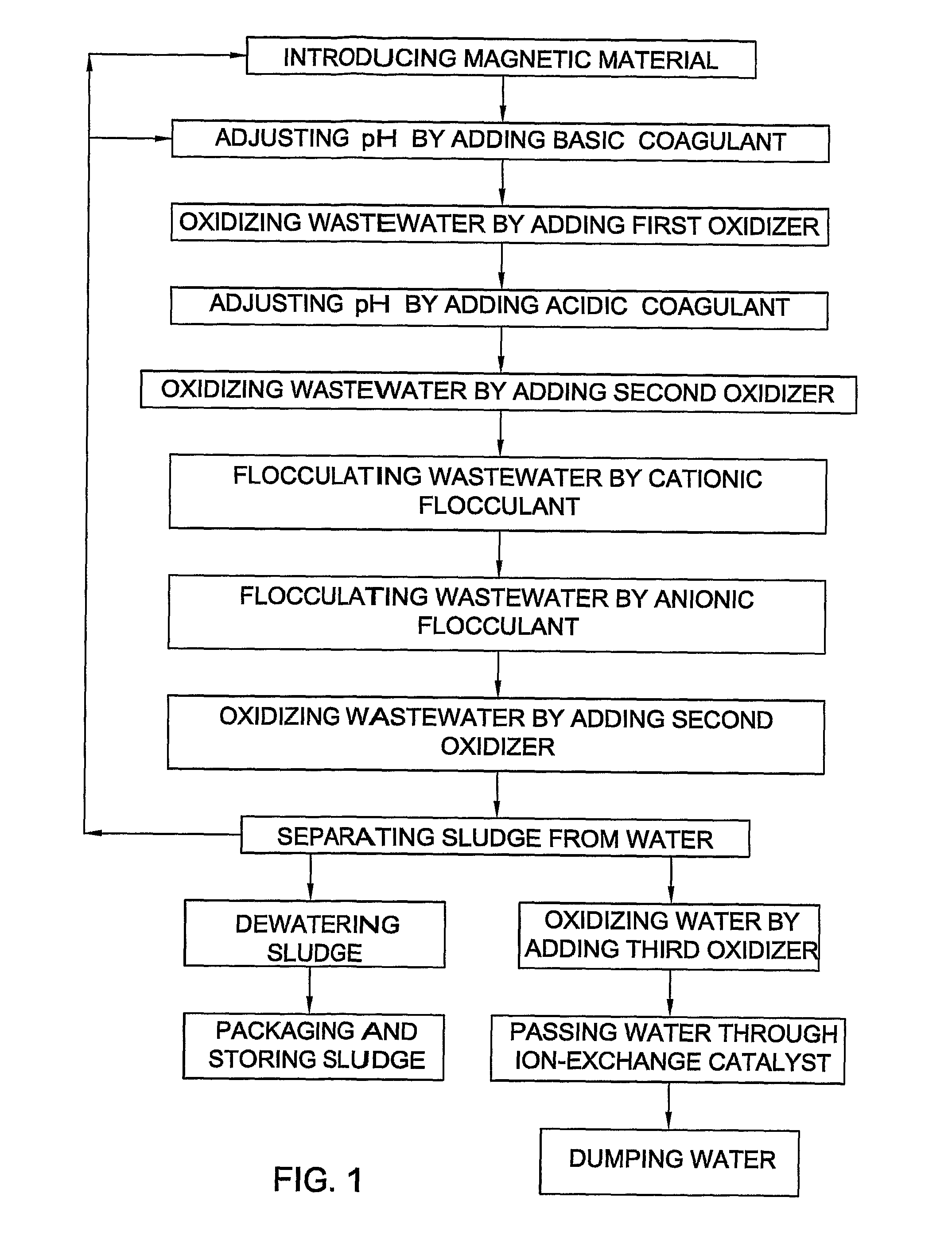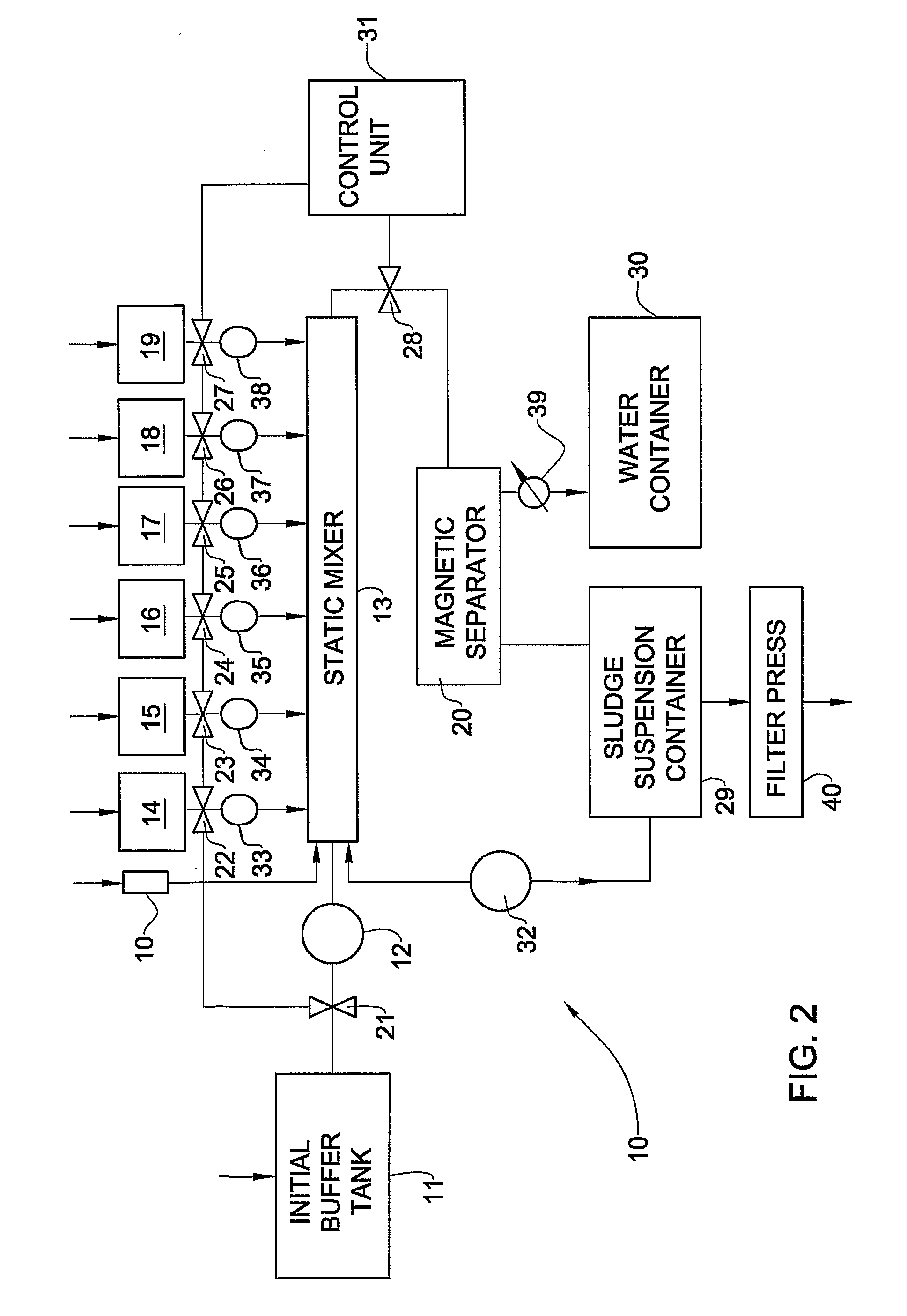System and Method for Treatment of Industrial Wastewater
a technology for industrial wastewater and treatment methods, applied in water cleaning, multi-stage water/sewage treatment, separation processes, etc., can solve the problems of inability to purify treated wastewater from organic impurities and heavy metals, incomplete oxidation of dissolved organic impurities, incomplete removal of intermediate oxidation products from wastewater, etc., to achieve effective coagulation and flocculation, high effluent water standard, and high efficiency
- Summary
- Abstract
- Description
- Claims
- Application Information
AI Technical Summary
Benefits of technology
Problems solved by technology
Method used
Image
Examples
example 1
[0094] Wastewater from a pond for a long-term conservation of toxic wastes of a regional center was treated in accordance with the method of the invention by the following way.
[0095] First, zinc ferrite powder was introduced into the wastewater taken from the neutralization process of waste etching solution used in the zinc coating process. Then, the wastewater was treated by basic coagulant (e.g., calcium hypo chlorite suspension) for adjusting the pH from its original value of 8.3 to the value of 10.5. After the primary coagulation stage, the wastewater was treated by acidic coagulant (e.g., aluminum sulfate) for adjusting the pH to the value of 7.5. The zinc ferrite fraction was set to 10 mass % of the total amount of calcium hypo chlorite and aluminum sulfate.
[0096] Further, an anionic flocculent was added based on poly acryl amide in the concentration of 10 mg / l. After the flocculation stage with the anionic flocculent, the wastewater was treated by cationic flocculant based ...
example 2
[0100] The wastewater from Example 1, firstly, was treated as described in Example 1. Thereafter, the water additionally passed through a column filled with the same catalyst, however in its basic form. The catalyst was converted from the neutral form to the basic form by preliminary washing in water with 5 mass % solution of caustic soda. The contact time of the treated water with the catalyst was 15 min. At the outlet from the column with the basic catalyst the water exposed the parameters presented in Table 2.
TABLE 2Water after theOutlet watertreatment as inafter further treatmentNoItemTable 1, mg / lwith basic catalyst, mg / l1COD180402Phenol0.0020.0013Formaldehyde2.80.074Oil products0.10.055Detergents0.56Sulfides0.040.0047Sulfates2201008Chlorides1,3006009Dry residue4,0002,50010General chromium0.020.0111Cadmium0.0050.004
example 3
[0101] The wastewater from Examples 1 was treated mainly in the sane way as described in Example 12 with the only difference that ozone was used as the oxidizer instead of hydrogen peroxide. The quantity of ozone used in the treatment was 10 mg per liter of the wastewater. As a result, at the exit from the column with the basic catalyst, the COD had the value of 45 mg / l. For comparison, the direct treatment of the same wastewater with only ozone in the amount of 100 mg per liter of the wastewater reduced COD to 53 mg / l.
PUM
| Property | Measurement | Unit |
|---|---|---|
| Percent by mass | aaaaa | aaaaa |
| Percent by mass | aaaaa | aaaaa |
| Percent by mass | aaaaa | aaaaa |
Abstract
Description
Claims
Application Information
 Login to View More
Login to View More - R&D
- Intellectual Property
- Life Sciences
- Materials
- Tech Scout
- Unparalleled Data Quality
- Higher Quality Content
- 60% Fewer Hallucinations
Browse by: Latest US Patents, China's latest patents, Technical Efficacy Thesaurus, Application Domain, Technology Topic, Popular Technical Reports.
© 2025 PatSnap. All rights reserved.Legal|Privacy policy|Modern Slavery Act Transparency Statement|Sitemap|About US| Contact US: help@patsnap.com



